Are you ready to dive into the fascinating world of slime-making? Join me as we explore the question, “What Can You Use as a Slime Activator?”. Slime-making has become a popular DIY trend, and understanding the different options for slime activators is key to creating the perfect slime. In this article, we’ll discuss the best slime activator options, including DIY alternatives, and provide you with essential tips and tricks for making slime at home.
Key Takeaways:
- Borax powder, liquid laundry starch, and Elmer’s slime activator are the three main slime activators.
- Borax powder creates thick slime, liquid laundry starch produces consistent slime, and Elmer’s slime activator works well with any type of glue.
- Other alternative slime activators include liquid soap, cornstarch, baking soda, and Epsom salt.
- Adjust the consistency of slime by adding more glue, borax, cornstarch, or water.
- Slime kits are available for easier slime-making, and there are alternative recipes that don’t use contact lens solution.
The Three Main Slime Activators: Borax Powder, Liquid Laundry Starch, and Elmer’s Slime Activator
Let’s start by exploring the three main slime activators: borax powder, liquid laundry starch, and Elmer’s slime activator. These are safe and commonly used options that can create different textures and consistencies of slime. Whether you’re looking for a thick and stretchy slime or a more fluid and gooey one, these activators have got you covered.
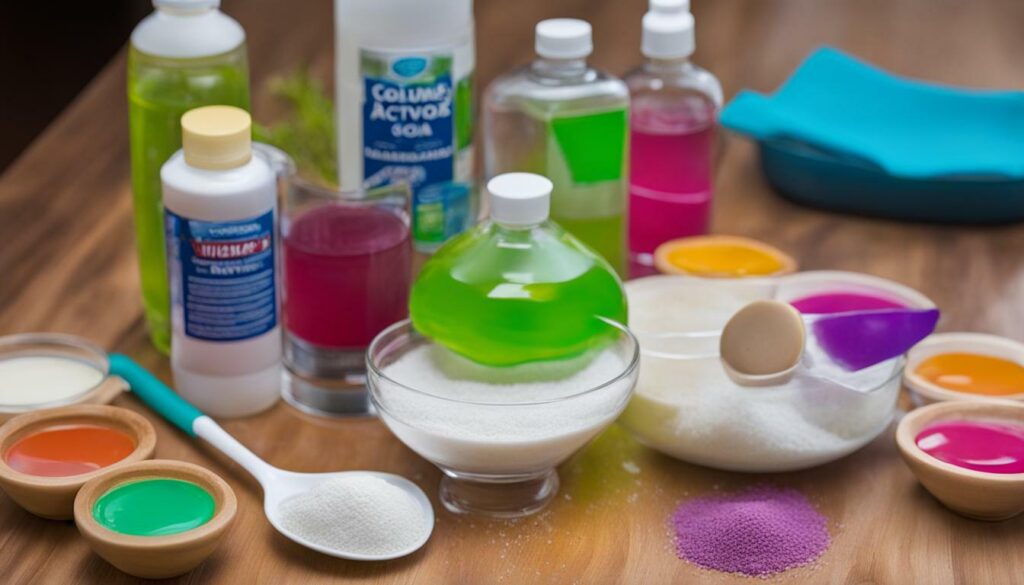

Borax powder is a popular choice for slime making as it creates the thickest slime. It is a natural mineral that is dissolved in water to act as a cross-linking agent, creating a stretchy and moldable slime. However, it is important to note that borax should be used in moderation and not ingested.
Liquid laundry starch, on the other hand, produces a consistent slime with a texture similar to traditional slime. It is easy to use, readily available in most households, and gives the slime a glossy finish. Liquid laundry starch works well for beginners and is a favorite among slime enthusiasts.
Elmer’s slime activator is another reliable option that works well with any type of glue. It creates a texture that is in between borax slime and liquid laundry starch slime. Elmer’s slime activator is known for producing a smooth and stretchy slime, and it is a great choice for those who prefer a less sticky slime.
In conclusion, these three main slime activators – borax powder, liquid laundry starch, and Elmer’s slime activator – offer a variety of options for creating your desired slime consistency. Whether you prefer a thick slime, a glossy slime, or a stretchy slime, these activators can help you achieve the perfect texture. Experiment with different ratios and combinations to discover your favorite slime recipe!
Other Alternative Slime Activators
If you’re looking for more options, there are several alternative slime activators you can try, including liquid soap, cornstarch, baking soda, and Epsom salt. These ingredients are often readily available in most households, making them convenient choices for slime-making.
Liquid soap, such as dish soap or hand soap, can be used as a slime activator. It helps bind the ingredients together and create a stretchy texture. Just be sure to use a clear or translucent soap to avoid color transfer to your slime.
Cornstarch, a common pantry staple, can easily double as a slime activator. It provides a thickening effect and helps create a gooey and moldable texture. Mix it with water to create a cornstarch solution and gradually add it to your slime mixture until you achieve the desired consistency.
Baking soda is another versatile ingredient that can be used as a slime activator. When combined with contact lens solution, it creates a chemical reaction that helps the slime solidify and become less sticky. This combination is particularly great for beginner slime-makers.
Epsom salt, commonly used in bath products and for muscle relaxation, can also be used as a slime activator. It helps improve the elasticity and stretchiness of the slime. Simply dissolve Epsom salt in warm water and add it to your slime mixture until you achieve the desired texture.
Summary:
- Liquid soap, cornstarch, baking soda, and Epsom salt are alternative slime activators.
- Liquid soap helps bind the ingredients together and create a stretchy texture.
- Cornstarch provides a thickening effect and creates a gooey, moldable texture.
- Baking soda, when combined with contact lens solution, helps solidify and reduce stickiness in slime.
- Epsom salt improves elasticity and stretchiness in slime.
| Slime Activators | Properties | Availability |
|---|---|---|
| Liquid Soap | Binds ingredients, creates stretchy texture | Readily available in most households |
| Cornstarch | Thickens, creates gooey, moldable texture | Common pantry staple |
| Baking Soda | Reduces stickiness, solidifies slime | Common household ingredient |
| Epsom Salt | Improves elasticity and stretchiness | Typically found in bath products |
If you’re looking to experiment with different slime activators, don’t be afraid to try these alternatives. They can add a fun twist to your slime-making adventures and provide endless opportunities for creativity. Remember to always follow safety guidelines and have adult supervision, especially when kids are involved. Enjoy the process and have a great time making your own homemade slime!
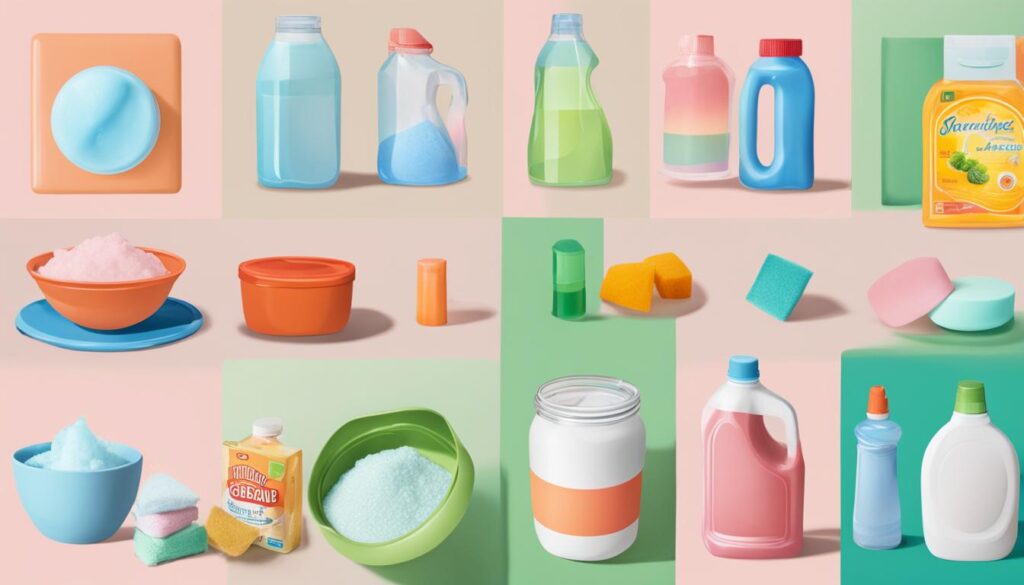

Please note that this article is for informational purposes only. The mentioned alternatives are suggestions, and it’s important to determine what works best for you and your unique slime recipe. Always ensure safety precautions are followed and supervise children during slime-making activities.
Slime Kits and Contact Lens Solution Alternatives
Making slime can be even easier with the help of slime kits, and we’ll also look at the best materials you’ll need to create your slimy masterpiece. Slime kits are designed to provide everything you need in one convenient package, making slime creation a breeze. These kits usually include glue, slime activator, and various add-ins like glitter, beads, or foam balls. They are great for beginners or those who prefer a hassle-free slime-making experience. With a slime kit, you can skip the hassle of searching for individual ingredients and focus on having fun!
When it comes to making slime, having the right materials is crucial. The best materials for making slime include Elmer’s white glue, Elmer’s clear glue, liquid laundry starch, borax powder, slime activator, soft clay, biodegradable glitter, measuring cups and spoons, craft aprons, instant snow, scentless lotion, mixing bowls, sharpie markers, slime containers, removable labels, stirring spoons, soap dye, and shaving cream. These materials not only help you achieve the perfect slime consistency but also allow you to get creative with colors, textures, and scents. Remember to use non-toxic and child-safe materials when making slime, especially if you’re doing it with kids.
Table 1: Essential Materials for Slime-Making
| Material | Description |
|---|---|
| Elmer’s glue (white or clear) | Main ingredient for slime |
| Liquid laundry starch | Common slime activator |
| Borax powder | Creates thick slime |
| Slime activator | Alternative to borax and laundry starch |
| Soft clay | Adds texture and color to slime |
| Biodegradable glitter | Enhances slime appearance |
| Measuring cups and spoons | Precise measurement of ingredients |
| Craft aprons | Protects clothes from stains |
| Mixing bowls | For combining ingredients |
| Stirring spoons | Blend ingredients thoroughly |
| Slime containers | Storage for finished slime |
As mentioned earlier, some popular slime recipes call for contact lens solution. However, contact lens solution can cause eye irritation and dryness, especially in sensitive individuals. That’s why it’s important to explore alternative recipes that don’t use contact lens solution. In this article, we provide 20 slime recipes without contact solution, including those using borax activator, laundry starch activator, baking soda activator, and alternative activators. These recipes are safe and fun to make, offering a wide range of colors, textures, and scents to suit your preferences.
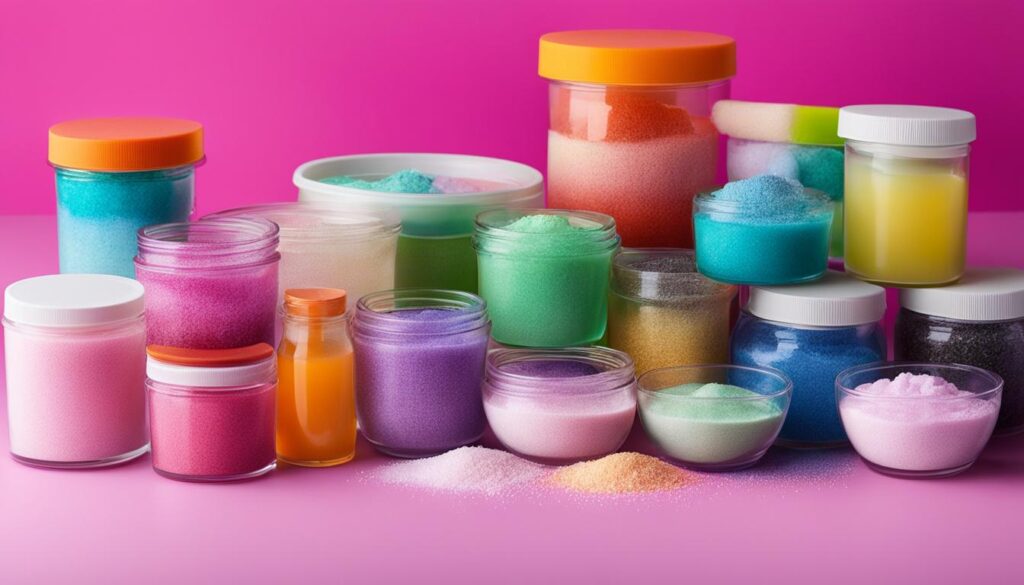

Homemade Slime Activators and Recipes
If you prefer to make your own slime activators, we’ve got you covered with homemade recipes and a variety of options to explore. Making your own slime activators allows for customization and control over the texture and consistency of your slime. Here are some easy and fun recipes using alternative activators:
Baking Soda Activator: Create a baking soda activator by mixing equal parts baking soda and warm water. Stir until the baking soda is completely dissolved. This activator works well with glue and produces a stretchy slime with a smooth texture.
Vinegar Activator: Combine equal parts white vinegar and warm water to create a vinegar activator. Mix well until the vinegar is fully diluted. This activator reacts with baking soda to produce a fizzy slime. Add baking soda gradually to achieve the desired consistency.
Liquid Starch and Baking Powder Activator: Mix 1 cup of liquid laundry starch with 1 tablespoon of baking powder to create this activator. Stir until the baking powder is fully incorporated. This activator creates thick and fluffy slime with a soothing texture.
| Alternative Activator | Recipe |
|---|---|
| Cornstarch Activator | Mix 1 cup of cornstarch with 1/2 cup of water. Adjust the consistency by adding more cornstarch or water as needed. |
| Saline Solution Activator | Combine 1/2 cup of saline solution with 1/2 teaspoon of baking soda. Stir until the baking soda is fully dissolved. This activator works best with glue and creates a stretchy slime. |
| Liquid Soap Activator | Use a clear liquid soap as an activator. Start with a small amount and add gradually until the desired consistency is achieved. This activator creates a glossy and stretchy slime. |
Remember to experiment with different ratios and ingredients to find the perfect slime activator for your desired slime texture. Have fun exploring these homemade options and get creative with your slime-making!
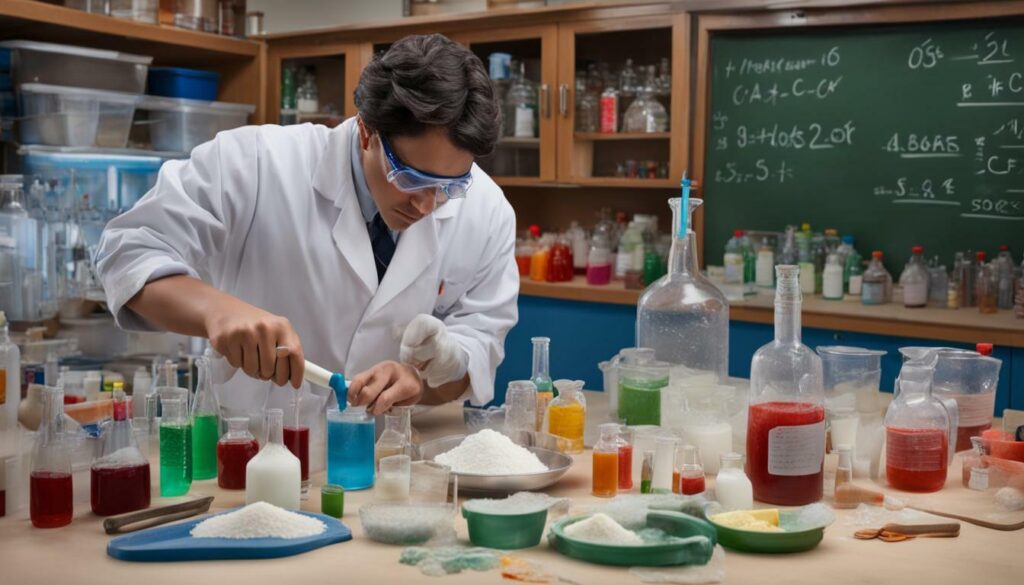

Essential Materials for Slime-Making
Before you dive into slime-making, make sure you have all the essential materials on hand to create the perfect batch of slime. From containers to measuring tools, these items will ensure a smooth and enjoyable slime-making experience. Let’s take a look at what you’ll need:
1. Slime Containers
Slime containers are essential for storing your slime and keeping it fresh. Look for containers that are airtight and leak-proof to prevent drying out or spilling. Clear containers are great for showcasing your colorful creations, while opaque containers can protect light-sensitive slimes.
2. Measuring Cups and Spoons
Precision is key when it comes to making slime, so having a set of measuring cups and spoons is crucial. Use these tools to accurately measure your ingredients and follow slime recipes. This will help you achieve the desired consistency and texture for your slime.
3. Mixing Bowls
Mixing bowls are where the magic happens! Choose bowls that are large enough to comfortably mix your slime ingredients without any spills or overflow. Opt for plastic or stainless steel bowls that are easy to clean and won’t react with the slime ingredients.
4. Stirring Spoons
Stirring spoons, or craft sticks, are essential for mixing all the ingredients together and creating your slime. Wooden craft sticks are a popular choice due to their affordability and disposable nature. Make sure to have plenty of stirring spoons on hand for hassle-free slime-making.
With these essential materials in your slime-making arsenal, you’ll be well-equipped to create endless batches of gooey, stretchy, and colorful slime! Let your imagination run wild as you experiment with different ingredients and textures to create your own unique slimes.
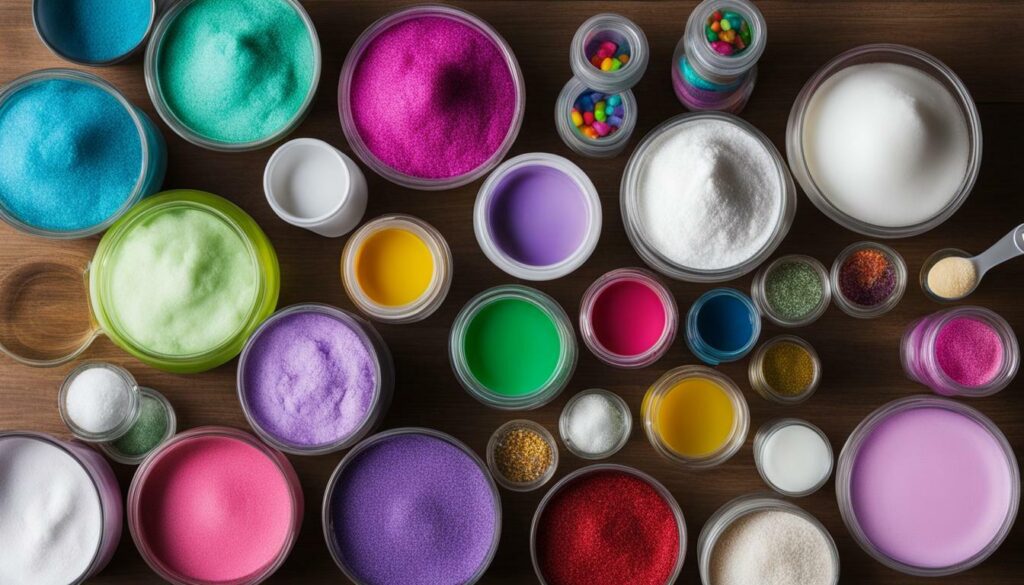

Summary:
Before you start making slime, ensure you have essential materials such as slime containers, measuring cups and spoons, mixing bowls, and stirring spoons. Slime containers are necessary for storing and preserving your slime. Measuring cups and spoons are crucial for precise measurements, ensuring the perfect consistency. Mixing bowls provide ample space for mixing ingredients, while stirring spoons help blend everything together. With these essential materials, you’ll be ready to embark on a fun and creative slime-making journey.
Conclusion: Fun and Affordable Slime-Making
Slime-making can be a fun and affordable activity for everyone, and you don’t need to break the bank on expensive contact solution to enjoy the slimy goodness. When making slime without contact solution, there are alternative slime activators that can be used. The three main slime activators that can be used are borax powder, liquid laundry starch, and Elmer’s slime activator.
Borax powder creates the thickest slime, while liquid laundry starch produces a consistent slime with a texture similar to traditional slime. Elmer’s slime activator works well with any type of glue and has a texture between borax slime and liquid laundry starch slime. If you prefer a natural or safe slime activator, options like liquid soap, cornstarch, baking soda, and Epsom salt can also be used.
Don’t worry if your slime doesn’t turn out perfectly the first time. Adjustments can be made by adding more glue, borax, cornstarch, or water to achieve the desired consistency. If you’re new to slime-making or want to make the process easier, slime kits are available that provide all the necessary materials.
To avoid eye irritation and dryness, it’s best to explore alternative recipes that don’t use contact lens solution. Homemade slime activators can be made using borax, liquid starch, or contact lens solution with baking soda. The possibilities are endless, and to get you started, here are 20 slime recipes that don’t require contact solution, including recipes using borax activator, laundry starch activator, baking soda activator, and alternative activators.
So gather your materials, follow a recipe, and let your creativity flow. Slime-making is a wonderful way to unleash your imagination and create something unique. With the countless fun alternative recipes available, you’ll never run out of ideas for your next slime creation. Enjoy the process, and have a slimy good time!
